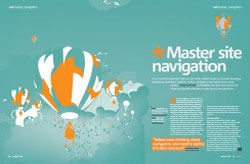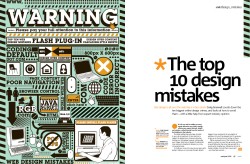Sometimes the best things in life start with a little mischief. That’s definitely the case with Bring Down IE6, a .net magazine microsite that I designed (using artwork from the wonderful people at ilovedust) and that launched on March 12.
Dan Oliver, the editor, was the culprit who lit the fuse. Knocking ideas around with me for features, he wondered if there was mileage in an article on the “growing trend to f—— IE”, meaning IE6, which even Facebook now hates. Being a web designer and also happening to know a lot of people who waste many hours dealing with IE6, I had a sneaking suspicion that, yes, this might just appeal to the mag’s readers.
The feature was duly commissioned, and I got to work, interviewing the likes of Jeff Zeldman and Bruce Lawson. I wrote the article, submitted it, and that was that. And then the mag hit the newsstands. Unusually, the article ended up online at the same time, rather than being delayed a few months, and there was one major addition: a badge.
Someone at .net had started a rallying cry, asking readers to download the ‘Bring Down IE6’ logo and link to the feature. But it didn’t seem loud enough. A spark went off in my head, and the microsite idea was born. It was then designed, built in suitably standards-compliant fashion, and IE6 was ignored bar an ‘upgrade’ notice that IE<7 users see. The finished site now sits at www.bringdownie6.com. Time will tell if it proves a success, but I’ve already seen the badge creeping out there and being attached to various designers’ blogs, which is heartening.
And despite the provocative and somewhat humorous tone of the site itself, the aim is deadly serious. It really is time for web designers to unite and finally get IE6 dealt with in some way. We need to move on, and together we will win.

Bring down IE6! All we need now is cheerleaders.
March 12, 2009. Read more in: .net, Design, Magazines, News, Technology, Web design
Click! Click! ARGH!
I’m a tad late in mentioning it, but I was again fortunate this month to pen .net’s cover feature, which this time was about site navigation.
As is often the case, it’s inevitable that personal opinion creeps in to these things, even if I’m not quoted myself. Through the words of others, my own preferences were pretty evident in the piece: a love for intuitive, simple, carefully labeled and consistent navigation. Perhaps surprisingly, this didn’t mean saying nasty things about Flash, and although I bit my tongue a couple of times, Adobe’s ubiquitous technology got a good showing and not a hammering.
What was hard, though, was deciding on the best-in-show sites: ten examples of top-notch navigation, each of which happened to be different enough from the others to warrant inclusion. These days, I’m pretty easily annoyed by websites, and many have absolutely ghastly navigation in so many ways.
Overall, I’m pretty happy with the sites I chose, which included Guardian, Adobe, Wieden+Kennedy, Apple and the BBC. It’s notable, though, that even in these leading sites, there are major problems: the BBC’s effort to make mainstream user-personalisation of the navigation experience is hampered by dreadful bulky design conventions; and Apple’s no-nonsense approach is gradually being eroded by things like utterly hateful ‘activate on hover’ Ajax drawers.
Truly, no-one gets things perfect, but the general tendency now appears to be towards inconsistency and being too clever for your own good. After recent years of simplification and honing down, and with devices like iPhone showing how simple and efficient navigation can be, that’s a worrying trend to see.

Are they trying to suggest we’re all talking a load of hot air? WE DEMAND THE TRUTH!
June 5, 2008. Read more in: .net, Magazines, Opinions, Web design
.net 176 on design screw-ups
It’s not often these days that I get catharsis when writing articles, but for .net 176 I got to vent, albeit through the words of others. Having worked on an overview of grid design for the previous issue (interesting and essential, but also very regimented subject matter), 176’s feature is about the top-ten design mistakes, including such gems as making Flash websites that look like HTML web pages, and version capping (telling people to ‘upgrade’ to a lower version of a plug-in or browser, because you stupidly set the then-current version as the sole requirement).
However, great fun as all this was, my own comment was mercilessly cut by the brutal editor (nothing to do with the fact that there simply wasn’t room, obviously), and it read: “When linking to PDFs, make that very clear, to avoid users’ browsers freezing up while Adobe Reader invades, leading to wailing, gnashing of teeth, and the subsequent ejection of laptops out of nearby windows.”
It amazes me that many web designers still do this sort of thing, even linking directly to a PDF from a site’s primary navigation. This, for me, is a design crime for which the culprit should be tarred, feathered, tarred again, and then dropped down a really deep well. Head first. Aaaand… relax.
You can grab the latest .net from netmag.co.uk, and if you’re outside of the UK, it’s called Practical Web Design for reasons that I still don’t entirely understand.

Luckily, the above .net image is not shown at full size.
May 1, 2008. Read more in: .net, Magazines, Web design


